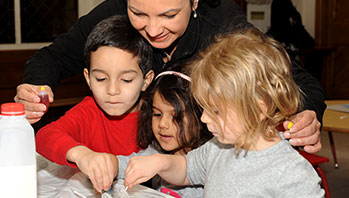- foam craft balls
- toothpicks
- build
- building
- roof
- wall
MA Standards:
English Language Arts/Speaking and Listening/SL.PK.MA.1 Participate in collaborative conversations with diverse partners during daily routines and play.
MA Draft Standards:
Physical Sciences/Matter and Its Interactions: Structure and Properties of Matter/PS1.A Describe, compare, sort and classify objects based on observable physical characteristics, uses, and whether it is manufactured as part of their classroom play and investigations of the natural and human-made world.
Physical Sciences/Motion and Stability; Forces and Interaction /PS2.C Explore the strength and stability of buildings as they build structures with different materials. [Cause and Effect, Stability and Change]
Head Start Outcomes:
Logic and Reasoning/Reasoning and Problem Solving Classifies, compares, and contrasts objects, events, and experiences.
Approaches to Learning/Initiative and Curiosity Demonstrates flexibility, imagination, and inventiveness in approaching tasks and activities.
PreK Learning Guidelines:
English Language Arts/Language 2 Participate actively in discussions, listen to the ideas of others, and ask and answer relevant questions.
Science and Technology/Inquiry Skills 3 Identify and use simple tools appropriately to extend observations.
Small Group: Foam Ball Houses

© Commonwealth of Massachusetts, Department of Early Education and Care (Jennifer Waddell photographer). All rights reserved.
STEM Key Concepts: Understand that different materials are useful for making different structures and different parts of structures
ELA Focus Skills: Creative Expression, Small Motor Skills, Follow Directions, Sequence, Vocabulary
Talk about the materials used to build houses and buildings. Tell children they are going explore making walls and roofs with foam craft balls and toothpicks.
- Demonstrate for children how to poke a toothpick through a foam ball. Stack four or five to show how to make a wall or part of a floor. Then tell children they are going to use foam balls and toothpicks to build houses.
- Demonstrate how to stick some toothpicks at an angle to construct a roof.
- Let children make their own shapes and explore ways to create houses. Be sure to take photos.
- Place each child’s house on tagboard, identified with his or her name. Display the houses for everyone to enjoy.
Reflect and Share
Invite children to talk about the house-building activity. Share the photos you took and have the materials available so children can demonstrate as they speak. Prompt discussion by asking questions, such as,
- Can you think of a way to add another room to your house? Encourage children to demonstrate and, if they wish, actually add a room.
- What material could you use to fill in the open spaces in the walls and roof? Guide children to conclude that they could use small pieces of construction paper or cardboard. Allow children to add the material, if they wish. Some children may also want to draw windows or a door on the fillers.
- How was building with foam balls and toothpicks different from building with blocks?
- Do you think foam balls would be a good material for making houses to live in? Why or why not?
Adaptation: You might prefer to have very young children use blunt bobby pins instead of toothpicks.
Social Emotional Tip: Help children learn to approach a task with flexibility and inventiveness and to demonstrate initiative by allowing them to make independent choices.
